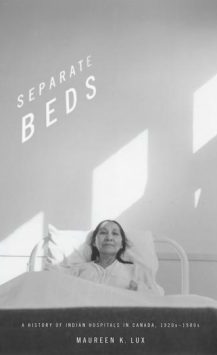In 1926 the Manitoba Paper Co. founded a company town called Pine Falls northeast of Winnipeg. The community grew to 3,200 people by the 1950s. Raw sewage and mill effluent, 80,000 gallons a day, were dumped in the Winnipeg River, the only source of drinking water for the nearby Sagkeeng First Nation. Children were sick.
The Pine Falls Hospital had plenty of fresh, clean beds – it ran at 43 percent capacity in the 1950s – but townspeople objected to Indians receiving care in the same ward with Caucasians, so authorities built an Indian hospital instead.
Historian Maureen Lux picks up the story: “Between 1949 and 1958, in a population of less than 1300, 462 infants were admitted to the Fort Alexander Indian Hospital and 19 died. In July 1958 alone, 33 infants were admitted and one died.” The Indian Hospital operated at 128 percent occupancy.
“The Indian Health Service field nurse reckoned that mothers were negligent for bottle-feeding instead of breastfeeding their infants,” Lux writes; “Accordingly she advised that children should be taken from the parents as soon as possible and enrolled in the Fort Alexander Residential School. But the school’s water supply, also contaminated by raw sewage, was suspected as the cause of an infectious hepatitis outbreak in 1954.”
In painstaking research and matter-of-fact reportage, Associate Professor Lux of Brock University documents Canadian apartheid. Separate Beds: A History of Indian Hospitals In Canada is a riveting and extraordinary account of mistreatment of citizens.
“Indian hospitals reflected the changing role of health care in an emerging welfare state, but they were also firmly rooted in persistent, century-long government policies that, regardless of political stripe, sought to protect, civilize and assimilate Aboriginal people,” writes Lux. “Such a remarkably consistent policy stemmed from the notion that Aboriginal people could not be considered true individuals in the classical liberal model that was hegemonic in Canada by the twentieth century.”
They were separate and unequal. Indian hospitals received a fraction of funding – as little as $4 a day for patients compared to $10 in general hospitals – and subsequently drew incompetent staff like the nurse at Pine Falls. Separate Beds recalls one Indian Health Service doctor who liked to diagnose patients from his car.
The heyday of Indian hospitals was short-lived but pernicious. “Overwhelmingly paternalistic, coercive in nature, and informed by the understanding of race as a biological reality that posed a threat to the nation’s health, Indian hospitals were the mid-century answer to the failures of the past,” Lux notes.
Consider Edmonton’s Camsell Hospital, opened in 1946, “the best the Indian Health Service had to offer,” writes Lux. It was opened by the Governor General and featured in a 1956 National Film Board production The Longer Trail.
What was it like? The building was decrepit with wiring rated a fire hazard. Sewer lines were ruptured and made the kitchen smell like dead rats. Fecal contamination in the water supply was blamed for a hepatitis outbreak in 1955. Linen went unwashed – surgeries were once cancelled due to lack of clean sheets – and the facility intended to care for 475 patients was soon stacked with 560 beds. The Camsell closed in 1996 due in part to asbestos contamination. This was the flagship Indian hospital.
“The history of Indian hospitals from the 1920s to 1970s is situated at the intersection of race, medicine and public policy,” explains Separate Beds.
Separate Beds: A History of Indian Hospitals In Canada 1920s – 1980s, by Maureen Lux; University of Toronto Press; 273 pages; ISBN 9781-4426-13867; $32.95








